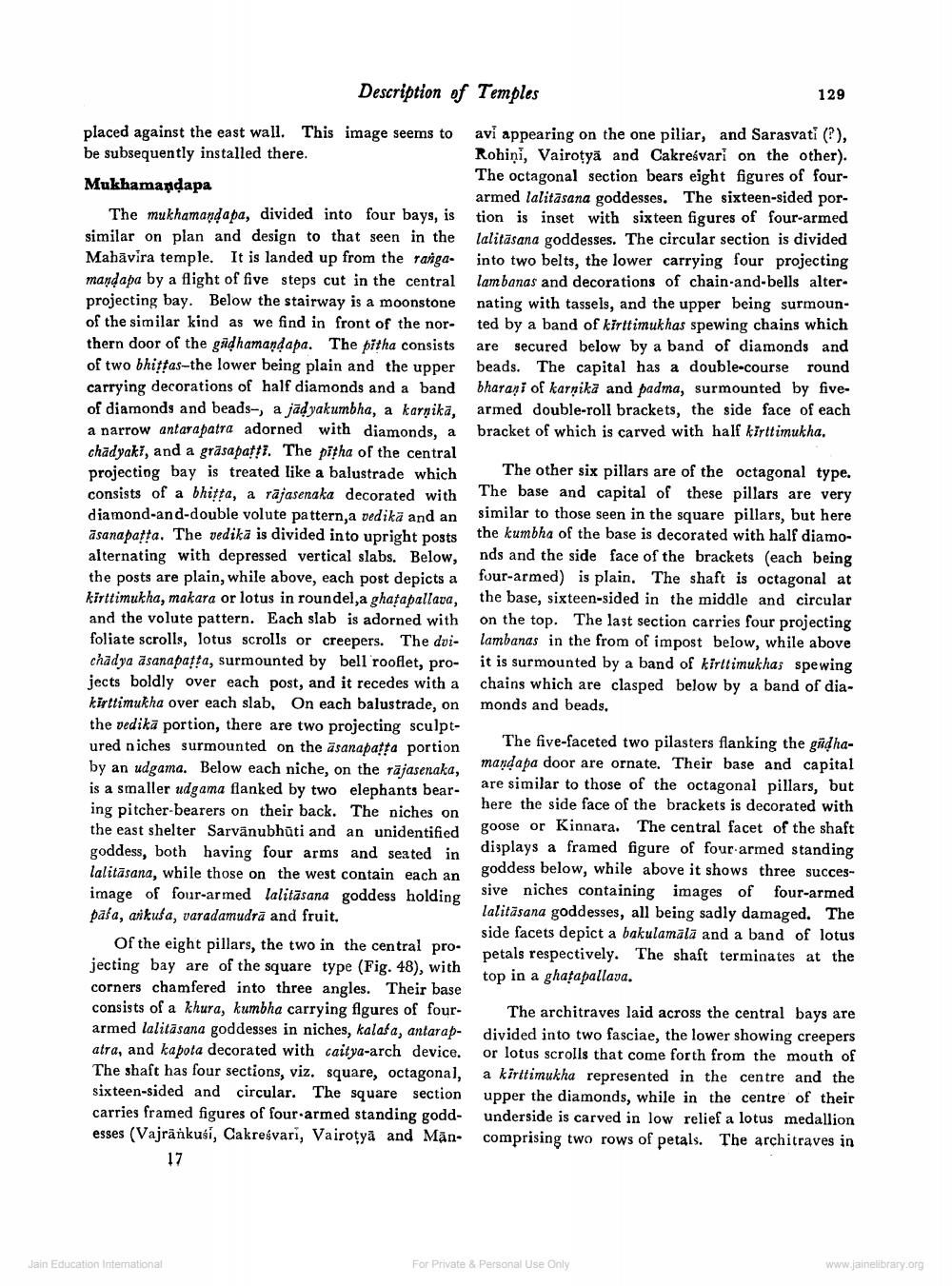________________
Description of Temples
129
placed against the east wall. This image seems to avi appearing on the one piliar, and Sarasvati ), be subsequently installed there.
Rohiņi, Vairotyä and Cakreśvari on the other).
The octagonal section bears eight figures of fourMukhamandapa
armed lalitāsana goddesses. The sixteen-sided porThe mukhamandaba, divided into four bays, is tion is inset with sixteen figures of four-armed similar on plan and design to that seen in the lalitāsana goddesses. The circular section is divided Mabävira temple. It is landed up from the ranga. into two belts, the lower carrying four projecting mandaba by a flight of five steps cut in the central lambanas and decorations of chain-and-bells alterprojecting bay. Below the stairway is a moonstone nating with tassels, and the upper being surmounof the similar kind as we find in front of the nor- ted by a band of kirttimukhas spewing chains which thern door of the gadhamandapa. The pitha consists are secured below by a band of diamonds and of two bhittas-the lower being plain and the upper beads. The capital has a double-course round carrying decorations of half diamonds and a band bharani of karnika and padma, surmounted by fiveof diamonds and beads-, a jadyakumbha, a karnika, armed double-roll brackets, the side face of each a narrow antara patra adorned with diamonds, a bracket of which is carved with half kiritimukha. chadyaki, and a grāsapatti. The pitha of the central projecting bay is treated like a balustrade which The other six pillars are of the octagonal type. consists of a bhitta, a rajasenaka decorated with The base and capital of these pillars are very diamond-and-double volute pattern, a vedikā and an similar to those seen in the square pillars, but here āsanapatta. The vedika is divided into upright posts the kumbha of the base is decorated with half diamoalternating with depressed vertical slabs. Below, nds and the side face of the brackets (each being the posts are plain, while above, each post depicts a four-armed) is plain. The shaft is octagonal at kirttimukha, makara or lotus in roundel,a ghatapallava, the base, sixteen-sided in the middle and circular and the volute pattern. Each slab is adorned with on the top. The last section carries four projecting foliate scrolls, lotus scrolls or creepers. The dvi- lambanas in the from of impost below, while above chadya āsanapatta, surmounted by bell rooflet, pro- it is surmounted by a band of kiritimukhas spewing jects boldly over each post, and it recedes with a chains which are clasped below by a band of diakirttimukha over each slab, On each balustrade, on monds and beads, the vedikā portion, there are two projecting sculptured niches surmounted on the asanapata portion
The five-faceted two pilasters flanking the gadhaby an udgama. Below each niche, on the räjasenaka,
mandapa door are ornate. Their base and capital is a smaller udgama flanked by two elephants bear
are similar to those of the octagonal pillars, but ing pitcher-bearers on their back. The niches on
here the side face of the brackets is decorated with the east shelter Sarvänubhūti and an unidentified
goose or Kinnara. The central facet of the shaft
goose goddess, both having four arms and seated in
displays a framed figure of four armed standing lalitāsana, while those on the west contain each an
goddess below, while above it shows three succes
go image of four-armed lalitāsana goddess holding
sive niches containing images of four-armed paša, aikufa, varadamudra and fruit,
lalitäsana goddesses, all being sadly damaged. The
side facets depict a bakulamala and a band of lotus Of the eight pillars, the two in the central pro
petals respectively. The shaft terminates at the jecting bay are of the square type (Fig. 48), with
top in a ghatapallava. corners chamfered into three angles. Their base consists of a khura, kumbha carrying figures of four- The architraves laid across the central bays are armed lalitasana goddesses in niches, kalaša, antarap- divided into two fasciae, the lower showing creepers atra, and kapota decorated with caitya-arch device. or lotus scrolls that come forth from the mouth of The shaft has four sections, viz. square, octagonal, a kiritimukha represented in the centre and the sixteen-sided and circular. The square section upper the diamonds, while in the centre of their carries framed figures of four armed standing godd- underside is carved in low relief a lotus medallion esses (Vajränkusi, Cakreśvari, Vairoty and Man- comprising two rows of petals. The architraves in
Jain Education International
For Private & Personal Use Only
www.jainelibrary.org




